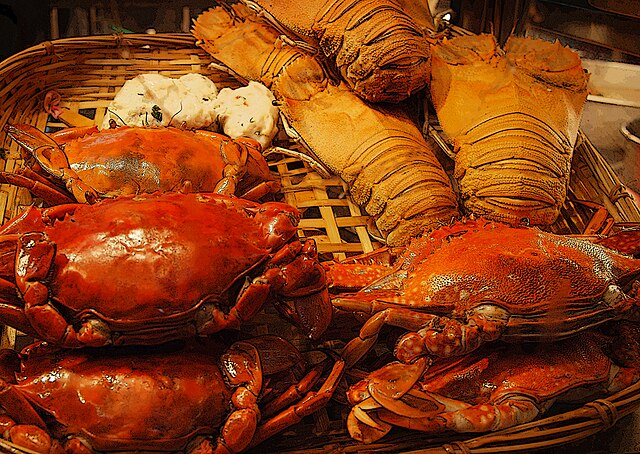Five curious happenings on climate, larvae exports and species’ invasion dominated lobster and crab news end October, 2023.
First, the fairly good news concerns the crab invasion on Canada’s Pacific coast in the week ending October 23.
Matt Peck, a researcher, recounted to The Guardian of finding a rocky coast off Haida Gwaii archipelago swimming with oyster-catchers. Their prize? Thousands of crabs that locals first spotted in 2020.
The crabs have since gained a commercial edge, as fishermen hauled in 30,000 of these crustaceans in 2022.
With the crab season nearing its twilight in 2023, local harvesters have so far trapped 200,000 of the invasive crabs. This illustrates a new phenomenon where new species invade a place and make it a permanent home.
And it is not just crabs: deer and seabirds have also populated this Canadian archipelago. Swarms of rats, too, devour chicks and birds’ eggs, threatening bird survival. Overall, the scene already evokes ancient patterns of animal distribution.
Next, the bad news regarding lobster.
Australia Lobster suffer Effects of Offshore Seismic Tests
Australia lobster in the deeps of the Western coast could be highly vulnerable to seismic aftershock. According to a scientific report published October 31, lobsters near offshore oil and wind energy tests suffered concussions.
Scientists say that crustaceans suffering the seismic shock look ‘dazed,” and cannot stand.
The report highlights the possible fatal effects on the rock lobster population in the fishing zone close to the tests. Coastal wind turbine installations and offshore gas drilling require preliminary tests such as these to gauge their viability.
Next, in Alaska, a goodly ten billion crabs just disappeared like that into thin air.
What happened to 10B Alaska Crabs?
Scientists on October 20 published a report about solving the mystery of ten billion dead crabs in Alaska’s Bering Sea. Between 2018 and 2021, 90% of the snow crab population of the chilly waters of Alaska mysteriously died off.
As a consequence, in 2022 and 2023 seasons, the state government postponed the respective harvests to replenish new crabs.
The finger of guilt quickly pointed to human activity but now scientists have found the answer in climate change. The journal Science says that marine heat waves of 2018-19 led to the mysterious disappearance.
The theory is that they died from starvation. Thought the crabs thrive with little food in Bering Sea’s temperatures of 35o F and below, when temperatures rise they must look for extra food.
Unfortunately, heat waves hinder plankton production in the sea. Indeed, snow crabs that fishermen caught in this area in 2020 looked smaller than earlier catches due to starvation.
And in Maine, Climate Affects Lobster way of Life
One of the best places to catch lobster in the U.S., is Maine. This, however may change if warm currents that heavy rainfall is causing, sustain.
Before publishing the report on October 30, USA Today’s team investigated the phenomenon. It found that new fish species are coming to lobster regions as the waters get warmer. This is threatening the availability of food for lobsters.
Finally, Indonesia is agitating renewal of the erstwhile controversial lobster larvae exports.
Indonesia to seek re-export of Lobster Larvae
Indonesia ceased to export lobster larvae in 2016 amid controversy. After the economic activity stopped for 7 years, now the south-east Asia nation wants to resume the practice.
Following a stillborn attempt to renew the trade in 2020, this time round, Indonesia’s government has brought a key requirement. For every cache of larvae buyers access from fishermen, they must return 2% of it to the sea.
If lobster traders adhere to this requirement, Indonesia may go ahead and resume a once-lucrative aquaculture practice.
In short, the above five happenings in the lobster and crab worlds reflect the deeply changing ecosystems of ocean life.
